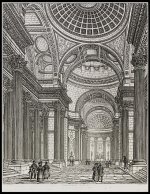The Hall of Glass Coffins


By Sim
- 2466 reads
THE HALL OF GLASS COFFINS
Every winter in Rome, one of the starlings migrating to the Mediterranean from the northern hemisphere detaches itself from its murmuring mother flock, flies blindly through the open hole at the summit of the domed roof of the Pantheon, and spirals around the great coffered ceiling, much to the delight of the people crowded below, who hold their breath until the bird pops out again into the sun, at which point they emit a huge, collective sigh.
This temple, built by the Roman Emperor Hadrian, was dedicated to not one but ALL the Olympian gods (to avoid one-upmanship). The circular oculus at the centre of its dome was intended to act not only as a sundial but as a channel for communication between heaven and earth.
Named after the Pantheon in Rome, the Pantheon in Paris – built one and a half thousand years later - also has an oculus, but much smaller this time and star-shaped, through which it is almost impossible for even the most determined starling to trespass.
The French temple, designed by Soufflot and Rondelet in the 18th century is far more ornate, as you’d expect, and was originally built as a church, but during the French Revolution was quickly deconsecrated and, in an act of secular defiance, dedicated instead to human heroes: specifically French ones. It became the last resting place for eminent scientests, writers and philosophers - people like Marie and Pierre Curie, Voltaire, Jean-Jacques Rousseau, Victor Hugo and others, who lie in their polished marble sepulchres on plinths in the vaulted Gothic crypt in the bowels of the building.
I first became interested in buildings when studying public art: a now defunct HND built around real contests and commissions, which is how I came to design the Here Today Gone Tomorrow Citizens’ Advice Bus for Lewisham council and the graffiti-inspired façade for the Brixton Fashion Centre – as featured every week on the Lenny Henry Show. (I’ll see if I can find the photos). So my fellow students and I were thrilled to be given the opportunity to visit Paris for a change and to take part in an arts festival to be held in and around the Pantheon. Our task was to design a temporary art installation which would enhance, not diminish, the sanctity of the place. (The highlight of the previous year’s festival – an animated film projected onto the buiding’s exterior illustrating the history of the building and its entombed residents, accompanied by the full-volume soundtrack of Les Mis, was widely considered over the top and never to be repeated).
Our Columbian student Luis (notorious for justifying his projects with endless expositions studded with phrases like “contextual regionalism” and “perpendicular to the urban grain” delivered in a sexy Colombian accent, and for claiming he had got it together with Annie Lennox in her changing room at the Albert Hall in 1988 after her adreneline-fuelled concert with the Eurythmics), proposed that a mosaic starling should be set into the plasterwork of the ceiling of the main sanctuary of the Pantheon as a subtle reference to the migrating starlings of Rome. On the other hand, Anastasia (whom Luis lustily stalked throughout our 2-year course until she set her husband onto him) proposed that a long, spidery ladder woven from blond human hair should be stretched from the oculus to the floor: a ladder which would glow gold whenever the sun reached its zenith, and whose shadow would act as a gnomen, marking out the hours on the surrounding walls.
But I was far more interested in the sleeping souls in the crypt. How sad for them that whilst tourists were able to climb up onto the domed roof above their heads to enjoy views of City of Light from its best vantage point, they had to spend eternity locked in the shadows of that cold, subterranean chamber.
So I proposed that those entombed celebrities should temporarily re-housed in glass coffins arranged in such a way that they could see and hear each other and have the benefit of one another’s posthumus company. “Just imagine the conversations”, I smiled, “between those great minds!”.
The festival jury debated long and hard, but finally, much to our amazement, agreed to adopt all three of our proposals, which they considered sufficiently obtuse and poetic. The management committee of the Pantheon who first came up with the idea agreed to apply for multiple permissions and find the funds to hire a scaffolding tower and employ expert stonemasons and body-handlers. The committee was also eager to use the opportunity to sponsor a forensic examination of the disenterred corpses: for scientific purposes, of course.
And a new musical “soundscape” was specially commissioned from Benois Surjat – resident composer for the Circus of the Sun - to create a soulful ambience for the exhibition.
Three months later Luis, Anastasia and I returned to Paris to create our works. Dustsheets went down to protect the marble floor of the sanctuary and scaffolding was erected to support the platform where Luis would lie upside-down, Michaelango-style, to work on his mosaic. Anastasia was shown a circle of comfortable chairs with access to a coffee machine where she and 11 quick-fingered lace-makers from Alencon would crochet her 83-metre long ladder out of the locks retreived from the floors of over 200 Finnish hair salons.
Benois Surjat was seen wandering around the building humming, shouting, banging his tuning fork against the columns, clapping and making other percussive sounds, which he recorded with his digital microphone: or else just standing, chin in hand, staring up at the ceiling.
I was taken down the narrow spiral staircase to the crypt and introduced to a team of enthusiastic craftspeople and archaeologists, who couldn’t wait to start dismantling the magnificent sarcophagi displayed in the vaulted niches of the mausoleum. The team unpacked their equipment and discussed at great length how to lift the lids off stone tombs sealed for generations without damaging them or their precious contents.
Now I‘ve read every book Emile Zola ever wrote, so as the hoist raised the top of his sarcophagus I leaned over to stare into the darkness in wonder, at the poor bare bones of my hero.
It took only a week to open the twelve selected tombs, gently remove their occupants and take samples of any remaining hair, teeth or skin for microscopic investigation before arranging the remains in fireproof, vandal proof, toughened glass coffins manufactured free of charge by glaziers Saint Gobelin, who used the opportunity to stick their logo in clear view on every casket, next to the name of the occupant. Then the caskets were arranged according to the plan I had drawn.
But some things look better on paper.
That evening, as I walked around the coffins – arranged in a circle like the numbers on the face of a clock - I felt no sense of satisfaction. I realised I had committed an unforgivable act of desecration.
The corpses stared at each other mutely with hollow eyes. Victor Hugo and Alexandre Dumas were unable to discuss their novels or even punch each other on the nose as they possessed neither fists nor noses. If Marie and and Pierre Curie could see each other like this there would be no more rows, just a profound sense of mutual pity; their love still intact but their bodies bodies falling apart. And Jean-Jacques Rousseau would weep to see Simone Weil, his philosophical successor, so .... shrivelled. At least he would, if he still had his eyes. So I cried for him.
Dem dry bones could no longer walk around.
The day before the grand opening, the builders worked late into the night dismantling the scaffolding. At last Luis could come down to earth and his lifelike starling could be revealed, flying around the lofty ceiling of the dome, while Anastasia’s delicate blond ladder trembled in the moonlight beaming down from the oculus.
The technicians tested the speakers, and suddenly Surjat’s music rang around the building. It was reminiscent of the sad waltz he once wrote for the aerial acrobats in “Saltimbanco”. The circular rhythm suited the flight of the mosaic bird around the oculus, and the circle of coffins on the floor below.
On a whim I crept down to the crypt. The lids had not been sealed very well, so I slid them open before returning to my hotel.
In the morning the doors of the Pantheon were flung open to the public. Many flocked into the main hall, and some found their way down to the the crypt, where they discovered a circle of intriguing glass coffins. With no contents.
Many people too clever for their own good came forward with theories. "They are based on the story of Snow White, who lay in a glass coffin awaiting the kiss of life from her prince”. “They represent the hours on the White Rabbit’s pocket watch. They are for people who have run out of time.”
Up in the sanctuary, some prople were staring up at Luis’s bird, but most people were admiring Anastasia’s ladder, now cordonned off from curious hands. As if someone had thrown a switch, the sun suddenly lit up the magical web.
A little girl pointed out to her mother that two of the ladder’s fragile rungs were broken. But her mother was too busy talking to notice.
Now if you happen to visit the crypt of the Pantheon in Paris, please visit the tomb of Jean-Jacques Rousseau and remember him not just for his terrible taste in wallpaper but for fathering modern democracy; Voltaire for his transformative political ideas and not just for being able to swallow an orange whole, while naked.
Remember Emile Zola not just for his poor clarinet playing but for campaigning for religious tolerance and social justice, and Marie Curie not just for dying from her own discovery, but for revolutionising modern medicine. Remember Simone Weil not just for finding Jesus while working on an assembly line, but for fighting for individual freedom and equal rights for women … and of course Josephine Baker not just for getting jiggy with it but for breaking down the barriers of racial inequality in the inter-war world of European Arts.
Please remember them for all they accomplished, because their achievements are all that remain of them. For their spirits have flown and their their tombs are utterly empty.
- Log in to post comments
Comments
wondeful story telling wich
wondeful story telling wich sounds very near the bone.
- Log in to post comments
Surreal, funny, altogether
Surreal, funny, altogether fabulous, Sim's first ghost story is Pick of the Day! Please do share if you can
the image is from here :
https://commons.wikimedia.org/wiki/File:Panth%C3%A9on,_Paris_(phbw10_0866).jpg
please change if you want
- Log in to post comments
Looks like it's time to write
Looks like it's time to write another one! Congratulations on your lovely golden cherries Sim!
- Log in to post comments
People in glass coffins
People in glass coffins should be very quiet and lie very still so as to not upset the other people.
Cheees! Tom
- Log in to post comments
Hi Sim
Hi Sim
Your writing is wonderful. I loved your ghostly story and look forward to more from you. a brave heroine to go down to the crypt to see the bones were indeed gone, from above and below. They left by the golden ladder. I love it. MM
- Log in to post comments


